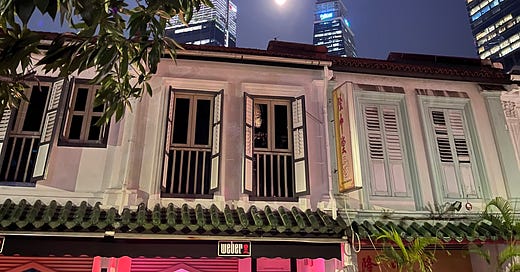37 marks another prime in my life, as my esteemed friend @zunamondin reminds me. What the incoming prime year brings remains to be seen, but it kicked off in fine fashion as I had the pleasure of catching up with
on his brief trip to Singapore, and hosting a dear colleague’s sister also passing through town.Every chance to converse with vgr yields new pathways of discovery. Anyone who follows his
and other writings will know of his interest in time and narrative, and the various ways we narrate time. Our conversation made me realise how surface my knowledge is of how the Chinese traditionally conceived of and constructed time, and how astronomy was synonymous with uncovering the mysteries of the cosmos and also, a tool for political intrigue. Time permitting, this will be my new rabbit hole.Another conversational thread, also tangential to time, was about the epic narratives of our respective ethnic cultures. I mentioned that I had devoted screen time to Ramayana-retelling Adipurush, and he in turn mentioned that he should probably rewatch Ponniyin Selvan. This is the intersection of said cultures, as the Chola Empire sent repeated embassies to China, and expanded its influence into Southeast Asia, where my family has lived for five generations now.
I promised to send more information on the Journey to the West epic, better known as the Monkey King in a recent Netflix production (tl;dw – it’s passable, but you could do so much better), beloved of millions of Chinese in the past, present and no doubt future. This is another intersection, as it fictionalises the account of how Buddhist sutras made its way from India to China, and is described by Kherdian as “arguably the most popular literary work in East Asia.” (Personally, mine is the Romance of the Three Kingdoms, but that is another epic for another post.)
DaeevyG on YouTube is a treasure trove I’ve recently discovered, and his explainer video about the comedy satire that is Journey to the West is well worth watching before diving into various versions of the epic itself.
For written material, I would recommend Jenner’s unabridged version from 1982, which is the English-language version I grew up reading, but it might be a bit much to plough through compared to Lovell’s snappier 2006 version. Both are worth considering. Maxine Hong Kingston’s debut novel Tripmaster Monkey is pretty much an ode to this classic, too.
Most of the visual material I grew up watching would be largely inaccessible to non-Asian audiences (unless you happen to know where to rent or stream TVB or CCTV material), so I’ll list what I think are seminal works and others you might more easily get your hands on.
CCTV’s 1986 Journey to the West and its 1999 sequel, for the Mandarin-heads.
TVB’s 1996 Journey to the West and its 1999 sequel. Oldie but goodie, beloved of Cantonese-understanding millions who grew up in the 90s and 00s.
Forbidden Kingdom (2008), starring Jet Li and Jackie Chan for the first time in their long careers. Any film choreographed by Yuen Woo-ping is worth watching in my books, especially if you’re an action fan, but this film was catered to an American audience and it shows. Not my thing, but could be yours.
Wu Kong (2017) is a very, very Chinese take on based on an internet novel; in true Chinese fashion, it does not feel as if it needs to cater to people not already in the know. Stunning cinematography, A-list pan-Sino cast, and excellent writing, but only if you’re already steeped in it.
Interestingly, Into the Badlands and American Born Chinese are also based on the Monkey King adventures. I enjoyed the latter, not because of Michelle Yeoh, but because it portrays the complex and sometimes-tortured reality of being Chinese-American.
Avoid The New Legends of Monkey on Netflix if you can; in terms of representation it feels deficient, and the plot tries to do too much with already fleshy source material, if such a thing could be conceived.
Until next week! I hope you’ll be suitably introduced to (or re-entertained by) this epic narrative.






